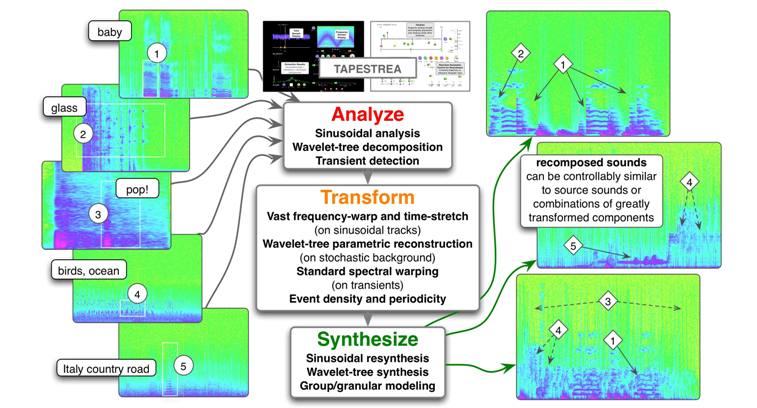TAPESTREA :
Techniques
And
Paradigms for
Expressive
Synthesis,
Transformation,
and
Rendering of
Environmental
Audio
(also known as taps)
- - - -
a -
new -
way -
to -
design -
sound
- - - -

what is it? :
TAPESTREA (or taps) is a
unified framework for interactively analyzing, transforming and
synthesizing complex sounds. Given one or more recordings, it
provides well-defined means to:
|
identify points of interest in the sound and extract them into
reusable templates
transform sound components independently of the background and/or
other events
continually resynthesize the background texture in a perceptually
convincing manner
controllably place event templates over backgrounds, using a novel
graphical user interface and/or scripts written in the ChucK audio programming
language
|
Taps provides a new way to completely transform a sound scene,
dynamically generate soundscapes of unlimited length, and compose and
design sound by combining elements from different recordings.
Tailored for sound designers, audio researchers, composers, and anyone
interested in experimenting with sound.
go forth and design cool sounds
Videos :
Sound
Scene Modeling by Example
(5 min, 67MB, mpeg-4)
Audio samples :
Etude pour un enfant seul
Etude
II (loom) |
Etude I
(zoo)
Flock
| Flock
(unplugged)
(1-minute versions of Etude.)
JNMR sound
examples
Pubs :
a
dissertation:
Techniques and Paradigms for Expressive Synthesis,
Transformation and Re-composition of Environmental Audio
ICMC06
paper:
Musical Tapestry: Re-composing Natural Sounds
Siggraph06
sketch |
DAFx06
paper |
ICMC08
group face demo
Reviews :
in
Computer Music Journal:
"Of the Thursday morning concert I would like to mention Loom (Etude II
pour un enfant seul), a collaborative work by Ge Wang, Perry Cook, and
Ananya Misra ... who received the award for the best ICMC paper at this
year's conference. Loom is a demo-style work, with excellent
transformation of natural sounds using software created at Princeton
University called TAPESTRA (available for download at
taps.cs.princeton.edu). The magical experience of listening to this work
was that most of the sound sources used were beautifully manipulated, but
nevertheless still identifiable."
-Silvia Matheus, 2006
|
|
|
